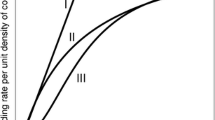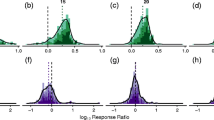Abstract
We study here general food web models that include non-Lotka-Volterra trophic interactions. We set two logical requirements that any such model must satisfy: (Cl) invariance under aggregation of identical species, and (C2) mathematical separation of disconnected subwebs. We show that these logical requirements are not always satisfied by previously published models. We give the mathematical expressions corresponding to generalizations of three nonlinear functional responses: Rolling (prey-dependent), DeAngelis-Beddington, and Holling-like ratio-dependent. We then address the two questions of species aggregation and of responses to basal production.
Access this chapter
Tax calculation will be finalised at checkout
Purchases are for personal use only
Preview
Unable to display preview. Download preview PDF.
Similar content being viewed by others
References
Abrams, P. A. 1993. Effect of increased productivity on the abundances of trophic levels. American Naturalist 141: 351–371.
Arditi, R. and H. R. Akçakaya. 1990. Underestimation of mutual interference of predators. 0ecologia 83: 358–361.
Arditi, R. and L. R. Ginzburg. 1989. Coupling in predator-prey dynamics: Ratio-dependence. Journal of Theoretical Biology 139: 311–326.
Arditi, R., L. R. Ginzburg, and H. R. Akçakaya. 1991. Variation in plankton densities among lakes: A case for ratio-dependent predation models. American Naturalist 138: 1287–1296.
Beddington, J. R. 1975. Mutual interference between parasites or predators and its effect on searching efficiency. Journal of Animal Ecology 44: 331–340.
Berryman, A. A. 1992. The origins and evolution of predator-prey theory. Ecology 73: 1530–1535.
Berryman, A. A., J. Michalski, A. P. Gutierrez, and R. Arditi. 1995. Logistic theory of food web dynamics. Ecology 76: 336–343.
Cyr, H. and M. L. Pace. 1993. Magnitude and patterns of herbivory in aquatic and terrestrial ecosystems. Nature 361: 148–150.
DeAngelis, D. L., R. A. Goldstein, and R. V. O’Neill. 1975. A model for trophic interaction. Ecology 56: 881–892.
Getz, W. M. 1984. Population dynamics: A per capita resource approach. Journal of Theoretical Biology 108: 623–643.
Getz, W. M. 1991. A unified approach to multi-species modeling. Natural Resources Modeling 5: 393–421.
Ginzburg, L. R. and H. R. Akçakaya. 1992. Consequences of ratio-dependent predation for steady-state properties of ecosystems. Ecology 73: 1536–1543.
Gomatam, J. 1974. A new model for interacting populations. I. Two-species systems. Bulletin of Mathematical Biology 36: 347–353.
Hairston, N. G., F. E. Smith, and L. B. Slobodkin, 1960. Community structure, population control and competition. American Naturalist 94: 421–425.
Hassell, M. P. and D. J. Rogers. 1972. Insect parasite responses in the development of population models. Journal of Animal Ecology 41: 661–676.
Hassell, M. P. and G. C. Varley. 1969. New inductive population model for insect parasites and its bearing on biological control. Nature 223: 1133–1137.
Hastings, A. and T. Powell, 1991. Chaos in a three species food chain. Ecology 72: 896–903.
Holling, C. S. 1959. The components of predation as revealed by a study of small mammal predation of the European pine sawfly. Canadian Entomologist 91: 293–320.
Ivlev, V. S. 1961. Experimental Ecology of the Feeding of Fishes. Yale University Press, New Haven, CT.
Jost, J. L., J. F. Drake, H. M. Tsuchiya, and A. G. Fredrickson. 1973. Microbial food chains and food webs. Journal of Theoretical Biology 41: 461–484.
Kretzschmar, M., R. M. Nisbet, and E. McCauley. 1993. Zooplankton grazing on competing algal populations. Theoretical Population Biology 44: 32–66.
Leibold, M. A. and H. M. Wilbur. 1992. Interactions between food-web structure and nutrients on pond organisms. Nature 360: 341–343.
León, J. A. and D. B. Tumpson. 1975. Competition between two species for two complementary or substitutable resources. Journal of Theoretical Biology 50: 185–201.
May, R. M. 1973. Stability and Complexity in Model Ecosystems. Princeton University Press, Princeton, NJ.
McCauley, E., W. W. Murdoch, and S. Watson. 1987. Simple models and variation in plankton densities among lakes. American Naturalist 132: 383–403.
McNaughton, S. J., M. Oesterheld, D. A. Frank, and K. J. Williams. 1989. Ecosystem-level patterns of primary productivity and herbivory in terrestrial habitats. Nature 341: 101–105.
Michalski, J. and R. Arditi. 1995. Food web structure at equilibrium and far from it: is it the same? Proceedings of the Royal Society of London B 259: 217–222.
Moen, J. and L. Oksanen. 1991. Ecosystem trends. Nature 353: 510.
Oksanen, L., S. D. Fretwell, J. Arruda, and P. Niemelä. 1981. Exploitation ecosystems in gradients of primary productivity. American Naturalist 118: 240–261.
Persson, L., G. Andersson, S. F. Hamrin, and L. Johansson. 1988. Predator regulation and primary production along the productivity gradient of temperate lake ecosystems. In Complex Interactions in Lake Communities, ed. S. R. Carpenter, pp. 45–65. Springer-Verlag, New York.
Pimm, S. L. 1982. Food Webs. Chapman and Hall, London.
Pimm, S. L. 1991. The Balance of Nature? Ecological Issues in the Conservation of Species and Communities. University of Chicago Press, Chicago.
Pimm, S. L. 1992. Frog ponds and ocean iron.Nature 360:298–299.
Pimm, S. L., J. H. Lawton, and J. E. Cohen. 1991. Food web patterns and their consequences. Nature 350: 669–674.
Polis, G. A. and R. D. Holt. 1992. Intraguild predation: The dynamics of complex trophic interactions. Trends in Ecology and Evolution 7: 151–154.
Real, L. A. 1977. The kinetics of functional re- sponse. American Naturalist 111: 289–300.
Rogers, D. J. and M. P. Hassell. 1974. General models for insect parasite and predator searching behaviour: Interference. Journal of Animal Ecology 43:239–253.
Rosenzweig, M. L. 1971. Paradox of enrichment: Destabilization of exploitation ecosystems in ecological time. Science 171: 385–387.
Slobodkin, L. B., F. E. Smith, and N. G. Hairston. 1967. Regulation in terrestrial ecosystems, and the implied balance of nature. American Naturalist 101: 109–124.
Strebel, D. E. and N. S. Goel. 1973. On the isocline methods for analyzing prey-predator interactions. Journal of Theoretical Biology 39: 211–234.
Takahashi, F. 1964. Reproduction curve with two equilibrium points: A consideration on the fluctuation of insect population. Researches in Population Ecology (Kyoto) 6:28–36.
Tostowaryk, W. 1972. The effect of prey defence on the functional response of Podisus modestus (Hemiptera: Pentatomidae) to densities of the sawflies Neodiprion swainei and N. pratti banksianae (Hymenoptera: Neodiprionidae). Canadian Entomologist 104:61–69.
Vandermeer, J. 1993. Loose coupling of predator-prey cycles: Entrainment, chaos, and intermittency in the classic MacArthur consumer-resource equations. American Naturalist 141: 687–716.
Watt, K. E. F. 1959. A mathematical model for the effect of densities of attacked and attacking species on the number attacked. Canadian Entomologist 91:129–144.
Yodzis, P. 1988. The indeterminacy of ecological interactions as perceived through perturbation experiments. Ecology 69: 508–515.
Editor information
Editors and Affiliations
Rights and permissions
Copyright information
© 1996 Springer Science+Business Media Dordrecht
About this chapter
Cite this chapter
Arditi, R., Michalski, J. (1996). Nonlinear Food Web Models and Their Responses to Increased Basal Productivity. In: Polis, G.A., Winemiller, K.O. (eds) Food Webs. Springer, Boston, MA. https://doi.org/10.1007/978-1-4615-7007-3_12
Download citation
DOI: https://doi.org/10.1007/978-1-4615-7007-3_12
Publisher Name: Springer, Boston, MA
Print ISBN: 978-1-4615-7009-7
Online ISBN: 978-1-4615-7007-3
eBook Packages: Springer Book Archive




